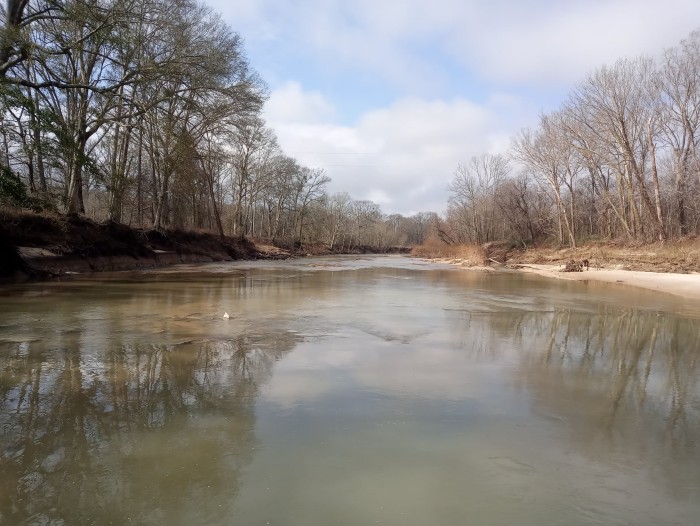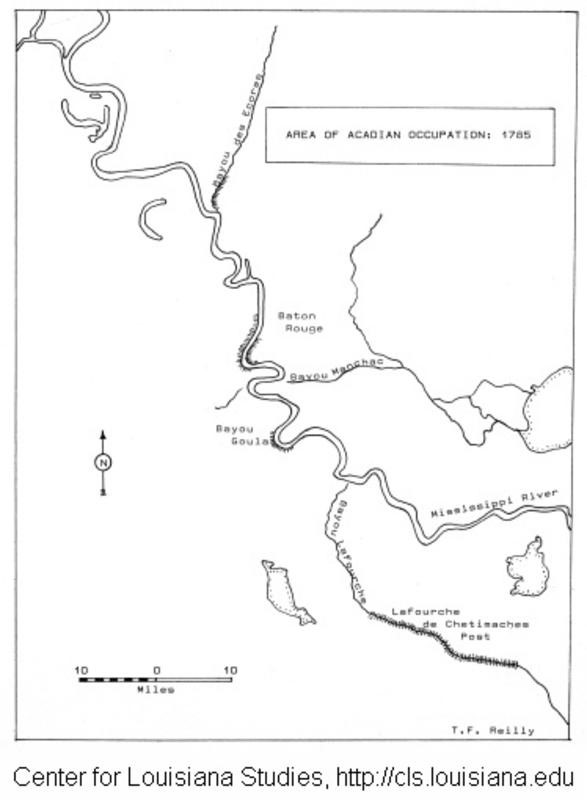
The Bayou des Écores, now Thompson Creek, is located in West Feliciana Parish, near Baton Rouge, some 66 kilometers north of the mouth of Bayou Lafourche on the Mississippi River. After the American Revolution, both Spain and the United States claimed the region. With a view to clearly mark the territory of Spanish Louisiana, Governor Esteban Miró in 1785 created the district of Feliciana on the eastern bank of the Mississippi, upstream from Baton Rouge, with its headquarters at present-day Port Hudson (formerly called Les Écores Blancs). The place is best known for the siege that took place there during the Civil War. The surrender of Port Hudson on July 9, 1863, gave the Union complete control of the Mississippi until the end of hostilities, which facilitated the supply of northern troops. In order to colonize the new district, Miró persuaded 53 of the 60 Acadian families aboard the La Ville d’Archangel ship to settle in Feliciana. The Acadians had just arrived from Saint-Malo (France) aboard this three-master vessel which reached New Orleans on December 3, 1785, after an ocean crossing of 113 days at sea. The majority of the remaining seven families preferred taking root along Bayou Lafourche.

The new district of Feliciana did not have a church. Moreover, the entire Spanish colony was marked by a weak presence of the clergy. When the Acadians reached the site in February 1786 which they baptized Bayou des Écores, in reference to the sandy (white sand) escarpments of the waterway that could be a danger to navigation, they decided to erect their church and their cemetery about eight kilometers upstream in front of Pointe Coupée whose origin dates back to 1720. See our travel book relating to the French Colonial Louisiana for more information about Pointe Coupée. The Bishop of New Orleans, Cyril Antonio Sieni, better known as Cyril of Barcelona, then appointed a Spanish Capuchin from Pointe Coupée to look after the Acadian families’ spiritual needs on the opposite riverbank. In this way, the designated priest only had to step over the Mississippi to celebrate Sunday Mass and administer the necessary sacraments. This explains why the registers of the parish church of Saint-François at Pointe Coupée (regarding births, baptisms, marriages, funerals and burials) contain Acadian names. Everyone was a winner…
A major move

Feeling isolated, a few Acadians from La Ville d’Archangel moved south towards the Acadian Coast shortly after settling in Bayou des Écores. Indeed, the Spanish authorities recorded a certain number of them in Baton Rouge as early as July 1788. Then, two destructive hurricanes struck the south of Louisiana in August 1793 and again in August 1794 devastating the community of the district of Feliciana. These disasters, combined with the previous loss of Acadian families and the absence of a resident priest, forced the rest of the Acadians to abandon Bayou des Écores. Some of them joined their parents at Baton Rouge, while many others preferred to settle along Bayou Lafourche.
Following the abandonment of the Feliciana District by the Acadians, the cultural future of the region failed to be determined by the French speaking Acadian refugees that Spain brought there in 1786. It was rather shaped by the Anglo-Americans who rose up against Spanish rule in 1810 under the Bonnie Blue flag of the Republic of West Florida. This is a whole different story of the United States of America that has nothing to do with the Stella Maris.
The Ville d’Archangel ship passenger list indicates the Acadian immigrants’ birthplace. The vast majority of them were born in France, more precisely in Cherbourg, Créhen, Jouvence, La Haute Marchandais, La Villeubel, Le Havre, Mordreuc, Nantes, Pleudihen-sur-Rance, Pleurtuit, Ploubalay, Plouër-sur- Rance, Saint-Énogat, Saint-Lunaire, Saint-Malo, Saint-Servan-sur-Mer, Saint-Suliac, Toul, and Tréméreuc. In addition, Jean-Baptiste, Marie and Perpétué Aucoin as well as Marie-Madeleine Landry were born in England. On the other hand, the Falkland Islands near Argentina are the birthplace of Ignace Granger.
